Andreas Weinmann
Performance Optimization of YOLO-FEDER FusionNet for Robust Drone Detection in Visually Complex Environments
Sep 17, 2025Abstract:Drone detection in visually complex environments remains challenging due to background clutter, small object scale, and camouflage effects. While generic object detectors like YOLO exhibit strong performance in low-texture scenes, their effectiveness degrades in cluttered environments with low object-background separability. To address these limitations, this work presents an enhanced iteration of YOLO-FEDER FusionNet -- a detection framework that integrates generic object detection with camouflage object detection techniques. Building upon the original architecture, the proposed iteration introduces systematic advancements in training data composition, feature fusion strategies, and backbone design. Specifically, the training process leverages large-scale, photo-realistic synthetic data, complemented by a small set of real-world samples, to enhance robustness under visually complex conditions. The contribution of intermediate multi-scale FEDER features is systematically evaluated, and detection performance is comprehensively benchmarked across multiple YOLO-based backbone configurations. Empirical results indicate that integrating intermediate FEDER features, in combination with backbone upgrades, contributes to notable performance improvements. In the most promising configuration -- YOLO-FEDER FusionNet with a YOLOv8l backbone and FEDER features derived from the DWD module -- these enhancements lead to a FNR reduction of up to 39.1 percentage points and a mAP increase of up to 62.8 percentage points at an IoU threshold of 0.5, compared to the initial baseline.
Fast Trajectory-Independent Model-Based Reconstruction Algorithm for Multi-Dimensional Magnetic Particle Imaging
May 28, 2025Abstract:Magnetic Particle Imaging (MPI) is a promising tomographic technique for visualizing the spatio-temporal distribution of superparamagnetic nanoparticles, with applications ranging from cancer detection to real-time cardiovascular monitoring. Traditional MPI reconstruction relies on either time-consuming calibration (measured system matrix) or model-based simulation of the forward operator. Recent developments have shown the applicability of Chebyshev polynomials to multi-dimensional Lissajous Field-Free Point (FFP) scans. This method is bound to the particular choice of sinusoidal scanning trajectories. In this paper, we present the first reconstruction on real 2D MPI data with a trajectory-independent model-based MPI reconstruction algorithm. We further develop the zero-shot Plug-and-Play (PnP) algorithm of the authors -- with automatic noise level estimation -- to address the present deconvolution problem, leveraging a state-of-the-art denoiser trained on natural images without retraining on MPI-specific data. We evaluate our method on the publicly available 2D FFP MPI dataset ``MPIdata: Equilibrium Model with Anisotropy", featuring scans of six phantoms acquired using a Bruker preclinical scanner. Moreover, we show reconstruction performed on custom data on a 2D scanner with additional high-frequency excitation field and partial data. Our results demonstrate strong reconstruction capabilities across different scanning scenarios -- setting a precedent for general-purpose, flexible model-based MPI reconstruction.
Remote Sensing Imagery for Flood Detection: Exploration of Augmentation Strategies
Apr 28, 2025
Abstract:Floods cause serious problems around the world. Responding quickly and effectively requires accurate and timely information about the affected areas. The effective use of Remote Sensing images for accurate flood detection requires specific detection methods. Typically, Deep Neural Networks are employed, which are trained on specific datasets. For the purpose of river flood detection in RGB imagery, we use the BlessemFlood21 dataset. We here explore the use of different augmentation strategies, ranging from basic approaches to more complex techniques, including optical distortion. By identifying effective strategies, we aim to refine the training process of state-of-the-art Deep Learning segmentation networks.
SynDroneVision: A Synthetic Dataset for Image-Based Drone Detection
Nov 08, 2024



Abstract:Developing robust drone detection systems is often constrained by the limited availability of large-scale annotated training data and the high costs associated with real-world data collection. However, leveraging synthetic data generated via game engine-based simulations provides a promising and cost-effective solution to overcome this issue. Therefore, we present SynDroneVision, a synthetic dataset specifically designed for RGB-based drone detection in surveillance applications. Featuring diverse backgrounds, lighting conditions, and drone models, SynDroneVision offers a comprehensive training foundation for deep learning algorithms. To evaluate the dataset's effectiveness, we perform a comparative analysis across a selection of recent YOLO detection models. Our findings demonstrate that SynDroneVision is a valuable resource for real-world data enrichment, achieving notable enhancements in model performance and robustness, while significantly reducing the time and costs of real-world data acquisition. SynDroneVision will be publicly released upon paper acceptance.
BlessemFlood21: Advancing Flood Analysis with a High-Resolution Georeferenced Dataset for Humanitarian Aid Support
Jul 06, 2024
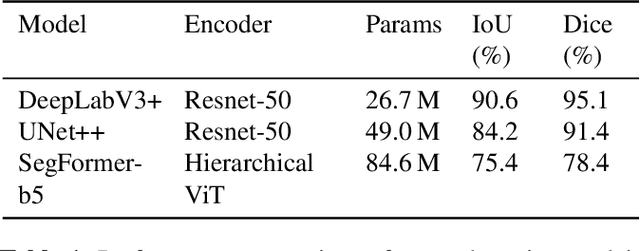
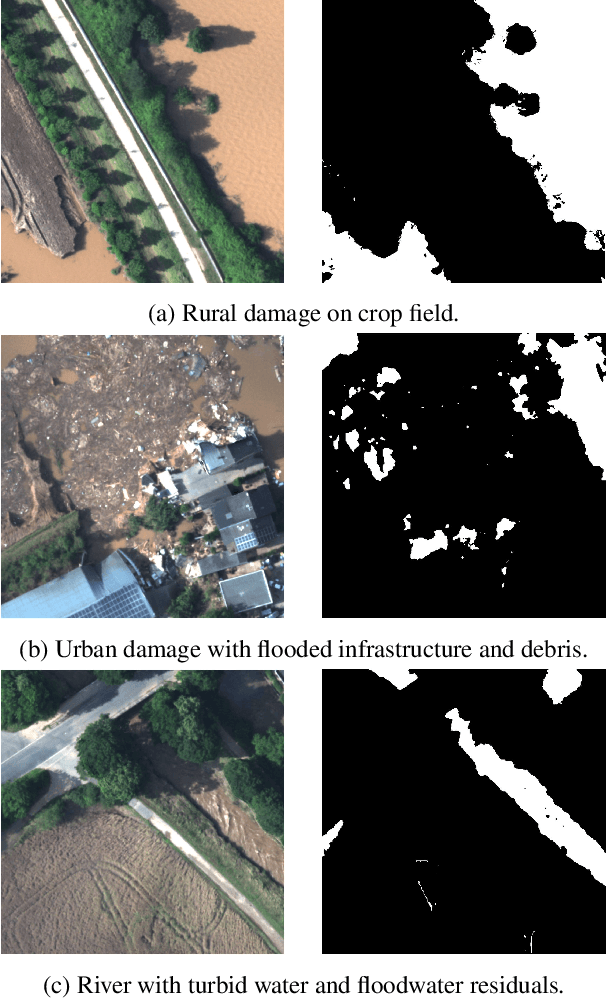

Abstract:Floods are an increasingly common global threat, causing emergencies and severe damage to infrastructure. During crises, organisations such as the World Food Programme use remotely sensed imagery, typically obtained through drones, for rapid situational analysis to plan life-saving actions. Computer Vision tools are needed to support task force experts on-site in the evaluation of the imagery to improve their efficiency and to allocate resources strategically. We introduce the BlessemFlood21 dataset to stimulate research on efficient flood detection tools. The imagery was acquired during the 2021 Erftstadt-Blessem flooding event and consists of high-resolution and georeferenced RGB-NIR images. In the resulting RGB dataset, the images are supplemented with detailed water masks, obtained via a semi-supervised human-in-the-loop technique, where in particular the NIR information is leveraged to classify pixels as either water or non-water. We evaluate our dataset by training and testing established Deep Learning models for semantic segmentation. With BlessemFlood21 we provide labeled high-resolution RGB data and a baseline for further development of algorithmic solutions tailored to flood detection in RGB imagery.
CNN Based Flank Predictor for Quadruped Animal Species
Jun 19, 2024



Abstract:The bilateral asymmetry of flanks of animals with visual body marks that uniquely identify an individual, complicates tasks like population estimations. Automatically generated additional information on the visible side of the animal would improve the accuracy for individual identification. In this study we used transfer learning on popular CNN image classification architectures to train a flank predictor that predicts the visible flank of quadruped mammalian species in images. We automatically derived the data labels from existing datasets originally labeled for animal pose estimation. We trained the models in two phases with different degrees of retraining. The developed models were evaluated in different scenarios of different unknown quadruped species in known and unknown environments. As a real-world scenario, we used a dataset of manually labeled Eurasian lynx (Lynx lynx) from camera traps in the Bavarian Forest National Park to evaluate the model. The best model, trained on an EfficientNetV2 backbone, achieved an accuracy of 88.70 % for the unknown species lynx in a complex habitat.
Automated Bioacoustic Monitoring for South African Bird Species on Unlabeled Data
Jun 19, 2024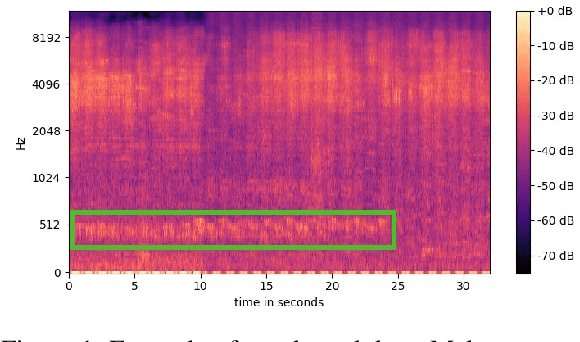
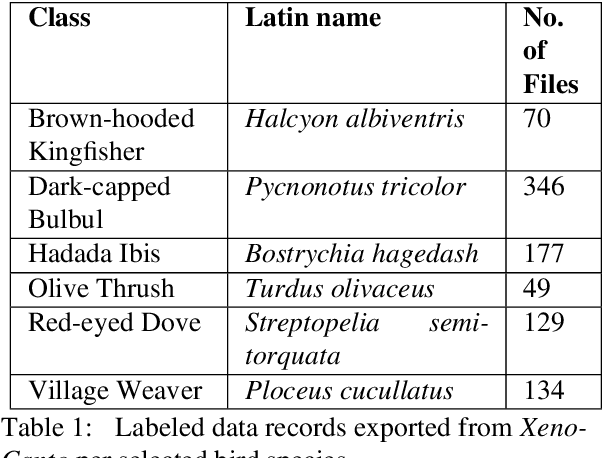
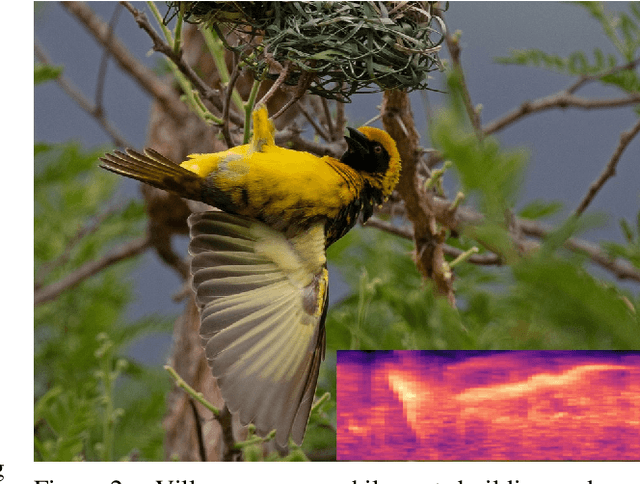

Abstract:Analyses for biodiversity monitoring based on passive acoustic monitoring (PAM) recordings is time-consuming and challenged by the presence of background noise in recordings. Existing models for sound event detection (SED) worked only on certain avian species and the development of further models required labeled data. The developed framework automatically extracted labeled data from available platforms for selected avian species. The labeled data were embedded into recordings, including environmental sounds and noise, and were used to train convolutional recurrent neural network (CRNN) models. The models were evaluated on unprocessed real world data recorded in urban KwaZulu-Natal habitats. The Adapted SED-CRNN model reached a F1 score of 0.73, demonstrating its efficiency under noisy, real-world conditions. The proposed approach to automatically extract labeled data for chosen avian species enables an easy adaption of PAM to other species and habitats for future conservation projects.
* preprint
YOLO-FEDER FusionNet: A Novel Deep Learning Architecture for Drone Detection
Jun 17, 2024



Abstract:Predominant methods for image-based drone detection frequently rely on employing generic object detection algorithms like YOLOv5. While proficient in identifying drones against homogeneous backgrounds, these algorithms often struggle in complex, highly textured environments. In such scenarios, drones seamlessly integrate into the background, creating camouflage effects that adversely affect the detection quality. To address this issue, we introduce a novel deep learning architecture called YOLO-FEDER FusionNet. Unlike conventional approaches, YOLO-FEDER FusionNet combines generic object detection methods with the specialized strength of camouflage object detection techniques to enhance drone detection capabilities. Comprehensive evaluations of YOLO-FEDER FusionNet show the efficiency of the proposed model and demonstrate substantial improvements in both reducing missed detections and false alarms.
CNN-based Game State Detection for a Foosball Table
Apr 08, 2024Abstract:The automation of games using Deep Reinforcement Learning Strategies (DRL) is a well-known challenge in AI research. While for feature extraction in a video game typically the whole image is used, this is hardly practical for many real world games. Instead, using a smaller game state reducing the dimension of the parameter space to include essential parameters only seems to be a promising approach. In the game of Foosball, a compact and comprehensive game state description consists of the positional shifts and rotations of the figures and the position of the ball over time. In particular, velocities and accelerations can be derived from consecutive time samples of the game state. In this paper, a figure detection system to determine the game state in Foosball is presented. We capture a dataset containing the rotations of the rods which were measured using accelerometers and the positional shifts were derived using traditional Computer Vision techniques (in a laboratory setting). This dataset is utilized to train Convolutional Neural Network (CNN) based end-to-end regression models to predict the rotations and shifts of each rod. We present an evaluation of our system using different state-of-the-art CNNs as base architectures for the regression model. We show that our system is able to predict the game state with high accuracy. By providing data for both black and white teams, the presented system is intended to provide the required data for future developments of Imitation Learning techniques w.r.t. to observing human players.
Low-Dose CT Image Reconstruction by Fine-Tuning a UNet Pretrained for Gaussian Denoising for the Downstream Task of Image Enhancement
Mar 06, 2024Abstract:Computed Tomography (CT) is a widely used medical imaging modality, and as it is based on ionizing radiation, it is desirable to minimize the radiation dose. However, a reduced radiation dose comes with reduced image quality, and reconstruction from low-dose CT (LDCT) data is still a challenging task which is subject to research. According to the LoDoPaB-CT benchmark, a benchmark for LDCT reconstruction, many state-of-the-art methods use pipelines involving UNet-type architectures. Specifically the top ranking method, ItNet, employs a three-stage process involving filtered backprojection (FBP), a UNet trained on CT data, and an iterative refinement step. In this paper, we propose a less complex two-stage method. The first stage also employs FBP, while the novelty lies in the training strategy for the second stage, characterized as the CT image enhancement stage. The crucial point of our approach is that the neural network is pretrained on a distinctly different pretraining task with non-CT data, namely Gaussian noise removal on a variety of natural grayscale images (photographs). We then fine-tune this network for the downstream task of CT image enhancement using pairs of LDCT images and corresponding normal-dose CT images (NDCT). Despite being notably simpler than the state-of-the-art, as the pretraining did not depend on domain-specific CT data and no further iterative refinement step was necessary, the proposed two-stage method achieves competitive results. The proposed method achieves a shared top ranking in the LoDoPaB-CT challenge and a first position with respect to the SSIM metric.
 Add to Chrome
Add to Chrome Add to Firefox
Add to Firefox Add to Edge
Add to Edge